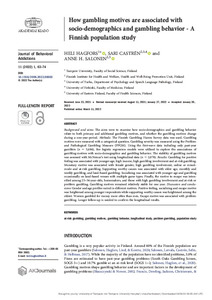How gambling motives are associated with socio-demographics and gambling behavior - A Finnish population study
Hagfors, Heli; Castrén, Sari; Salonen, Anne H. (2022-03-31)
Hagfors, Heli
Castrén, Sari
Salonen, Anne H.
31.03.2022
Julkaisun pysyvä osoite on
https://urn.fi/URN:NBN:fi:tuni-202204263622
https://urn.fi/URN:NBN:fi:tuni-202204263622
Kuvaus
Peer reviewed
Tiivistelmä
Background and aims: The aims were to examine how socio-demographics and gambling behavior relate to both primary and additional gambling motives, and whether the gambling motives change during a one-year-period. Methods: The Finnish Gambling Harms Survey data was used. Gambling motives were measured with a categorical question. Gambling severity was measured using the Problem and Pathological Gambling Measure (PPGM). Using the first-wave data including only past-year gamblers (n = 5,684), five logistic regression models were utilized to explore the associations of gambling motives with socio-demographics and gambling behavior. The stability of gambling motives was assessed with McNemar's test using longitudinal data (n = 2,078). Results: Gambling for positive feeling was associated with younger age, high income, high gambling involvement and at-risk gambling. Monetary motive was associated with female gender, high gambling involvement, online or mixed-mode and at-risk gambling. Supporting worthy causes was associated with older age, monthly and weekly gambling, and land-based gambling. Socializing was associated with younger age and gambling occasionally on land-based venues with multiple game types. Finally, the motive to escape was intensified among 25-34-year-olds, homemakers, and those with high gambling involvement and at-risk or problem gambling. Gambling motives remained relatively stable for one year. Discussion and conclusions: Gender and age profiles varied in different motives. Positive feeling, socializing and escape motive was heightened among younger respondents while supporting worthy causes was heightened among the oldest. Women gambled for money more often than men. Escape motive was associated with problem gambling. Longer follow-up is needed to confirm the longitudinal results.
Kokoelmat
- TUNICRIS-julkaisut [16951]
